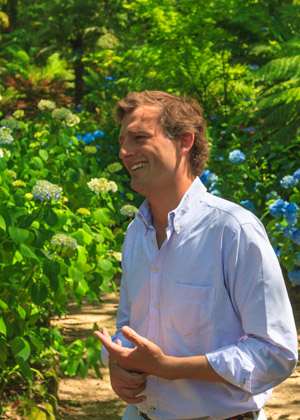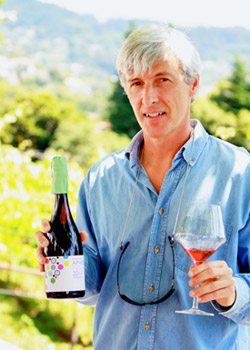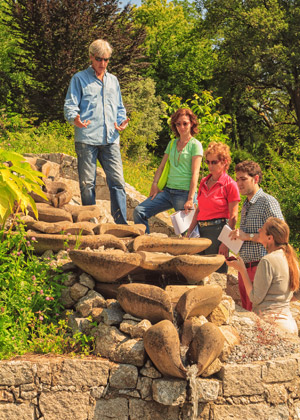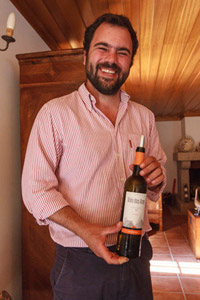
Aveleda’s modern winery maintains its sense of history
The best winemakers I know juxtapose two intriguing characteristics – great talent, and appealing humility. Ask a great winemaker how she or he made a certain wine and invariably she will say she didn’t really make it, “it’s made in the vineyard.” Talented winemakers give a great deal of credit to Mother Nature and often portray themselves as stewards rather than vinous alchemists conjuring fine wine out of nothing.
I love this quality and it’s one reason I feel so blessed to count some great winemakers among my friends. Protestations aside, they are great winemakers, bringing a beguiling mix of science, memory and grape-whispering to the vats of grapes supplied by nature (with a lot of help from growers) to put memorable wine in bottles year after year.
When I visit a wine region, as I did last month in a trip to Portugal’s verdant Vinho Verde, I’m usually bored by winery tours (most wineries are spiritual if not physical clones of one another), and almost always happy to walk in vineyards. Vineyards are definitely not carbon copies of one another – the subtle differences, and the impact on what we wine lovers get to drink, is enormous. The only way to really grasp the soul of a wine is to feel the angle of the sun, to smell the residue of rain on the leaves (or sense its lack) and to try walking among rocks and dirt to understand the vines’ environment. The incline of vineyards, the spacing of the rows, the health of the grapes are all still relevant to us non-scientist consumers. Even without chemical formulas coursing through our brains, we can make links between the memory of soil and the flavors of a wine. It’s not like tasting mud, but neither is it a process devoid of dirt either.
I remember once having the good fortune of staying at a winery in St. Emilion in Bordeaux; in those days I was a jogger and so a friend and I went for an early morning run skirting the tidy vineyard of “our chateau.” The run became progressively more difficult as our shoes clumped up with bits of clay from the vineyard. I had read about clay and how it affects drainage; I’d studied clay but I think until I had to spend an hour cleaning my shoes that morning I didn’t really understand clay. It’s heavy and impermeable and so of course it affects drainage. For ah-ha moments, one run in a vineyard trumped an entire shelf of wine books.
 Francisco Guedes of Quinta da Aveleda |
That run came to mind in Portugal as I kicked from my shoes the dust of perfectly manicured rows of vines in the gently rolling home vineyard of 350 year old Quinta da Aveleda. When the amiable Francisco Guedes offered a cool glass of Aveleda’s crisp Vinho Verde, the dust bonded in my mind with the steely edge of the wine and I recalled the flinty flavor of pebbles I’d put in my mouth as a child.
Francisco is a member of the fifth generation of his family to own Aveleda. “I have dozens of cousins in the business!” he says. His father was a diplomat and he grew up in half a dozen countries around the world, yet, as he will explain in any of the six languages he speaks, Vinho Verde is home, and his passionate bond with this land and this wine is palpable.
 Vasco Croft, the visionary owner of Aphros Winery |
Later, a few miles away in the village of Braga, I walked around the far less manicured grounds of the biodynamically farmed Aphros. Here, where the air is heavy with aromas of wild herbs and shrubs, the minimally tended hills are steeper and the vineyards get stronger light, vigneron Vasco Croft feels a passion as well. In a glass of the stunning wine he makes from the traditional Loureiro grape, I held a liquid version of those stark contrasts, and in Vasco Croft saw another part of the soul of Vinho Verde. Aphros is a biodynamic winery, and he’s committed to tending his vines and picking his grapes by phases of the moon, using herbal tinctures in his vineyard and employing principals of feng shui in directing the flow of water to his vines. Vasco’s neighbors don’t understand what he’s doing and perhaps that is why he exports nearly all of his wine (the US is his largest consumer). I loved his wine yet everything Vasco Croft does in service to his vines, from harvesting by the moon to using a contemporary label, seems to fly in the face of traditions of his region. Some of those traditions are evolving and while some in the region are uneasy, over time what are traditions if not of a record of how people work and change, handed down through the generations?
 Feng-Shui Fountain at Aphros
|
This is the key. These wines are still made by people, and the real story isn’t the grapes, though they provide the flavor, and it isn’t only the terrain, though that affects the wines. With the best wines, it’s the soul and personality behind the effort that gets the grapes in the bottle. One of my favorite stops rambling about the mountain of Vinho Verde was MQ Vinhos, Miguel Quiemado’s tiny winery (he and winemaker Gabriela Albuquerque made only 4,000 bottles in 2012 their first year) in Sá, a village so small that an address is superficial; Miguel prints his latitude and longitude on his business card.
Winemaker Gabriela, trained in a Portugal trying to revitalize its wine industry with funding from the European Union, has worked hard to gain an international perspective. I asked her how she sees technology changing wine in Vinho Verde – after all, she’s returned to an exceedingly rustic area after working as a winemaker in New Zealand, the poster child of wine technology innovation. I expected talk of tanks, pumps, vine spacing and trellises and instead got a sharp look followed by a smile. “Technology won’t change wine, it’s our passion that will change the wine.” Am I crazy for getting a catch in the throat at a statement like that? I don’t think so – sincerity trumps even soil.
 Miguel Quiemado of Vale dos Ares |
That passion can be tasted, too – in its first vintage Vale dos Ares, the wine she and Miguel are making on their sun-bleached mountain top, was one my favorite wines of Vinho Verde. So here are some glimpses of what is really going on in Vinho Verde – a passionate area, creating wonderful and affordable wines thanks to grapes, yes, and especially to people like Francisco Guedes, Vasco Croft and Miguel Queimado who make wine but pour their passion into the bottle and into my glass.
Text and Photos © 2013 Lyn Farmer, All Rights Reserved
